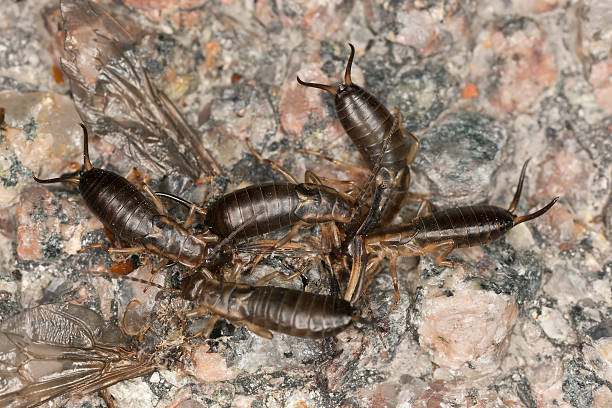
Earwig Pest Control in Toronto

Earwig IdentificationEarwigs are insects that belong to the order Dermaptera, which means skin wings. They have a long, flat body with a hard, reddish-brown shell and a pair of forcep-like pincers on their abdomen. They also have two pairs of wings, but the hindwings are folded under the short, rarely used forewings. Earwigs have antennae that are about half as long as their body, and they vary in size from 1.5 to 2.0 cm (.59 to .79 inches) long. The pincers are used for defense, courtship, and handling food. The male earwigs have larger, curved pincers, while the female earwigs have smaller, straighter ones.
Why do I have earwigs ?Earwigs are scavengers that feed on a wide variety of organic matter and other insects. They are mostly nocturnal and hide in moist, dark places during the day. They can be found in gardens, compost piles, wood piles, mulch, leaf litter, under stones, in cracks and crevices, and sometimes inside houses. Earwigs may enter your home in search of food and shelter, especially during dry, hot weather or when their outdoor habitats are disturbed. They may also hitchhike on cut flowers, vegetables, or other plants that you bring indoors. Earwigs are not attracted to human ears, despite the old myth that they crawl into them and lay eggs.
How worried should I be about earwigs ?Earwigs are not directly harmful to humans. They do not bite or sting, and they do not transmit diseases. They may pinch you with their pincers if you handle them roughly, but this is usually not very painful or dangerous. Earwigs are not known to cause any serious damage to buildings or furniture, although they may leave behind some fecal droppings or foul-smelling secretions. Earwigs may cause some problems for your plants, however, as they feed on the tender shoots, leaves, flowers, fruits, and vegetables of many crops and ornamental plants. They may also prey on beneficial insects, such as ladybugs and lacewings, that help control pests. Earwigs are sometimes considered beneficial themselves, as they scavenge decaying matter and eat insect larvae, slug eggs, aphids, and other garden pests.
How can I prevent earwigs from invading ?There are several steps you can take to prevent earwigs from invading your home and garden. Here are some tips:
Keep your home and garden clean and dry. Remove any excess debris, decaying organic matter, and moisture sources that may attract or shelter earwigs. Trim back vegetation and mulch away from your foundation, and repair any leaky faucets or pipes. Make sure your gutters and downspouts are clear and direct water away from your house.
Seal any cracks or gaps that may allow earwigs to enter your home. Use caulk, weather stripping, screens, or mesh to cover any openings around doors, windows, vents, pipes, or wires. Check your basement, crawl space, attic, and garage for any potential entry points.
If you want to prevent earwigs from invading your home or garden, you may benefit from hiring a pest control company that can offer you professional and effective solutions. A pest control company can help you by:
Inspecting your property for signs of earwig activity and identifying the sources of infestation.
Applying appropriate treatments to eliminate earwigs and prevent them from coming back. These may include insecticides, baits, traps, or natural methods, depending on your preference and situation.
Providing you with advice and recommendations on how to maintain a clean and dry environment that discourages earwigs from entering or nesting.
Offering you a guarantee or warranty for their service, so you can rest assured that your earwig problem will be solved.
If you have a severe earwig infestation, you may need to contact a professional pest control service to help you get rid of them. They can use more effective and safe methods to eliminate earwigs and prevent them from coming back.
When to call an earwig exterminator ?The best is to call us as soon as possible. We service the Greater Toronto Area, call us now 647 849 4441
Earwigs
PEST CONTROL
GTA Exterminators for earwig removal in Toronto
Call us today for earwig extermination
